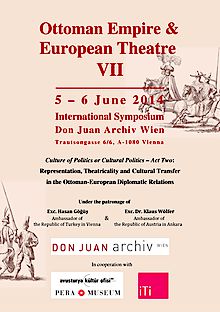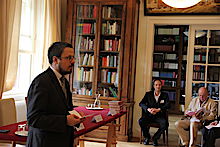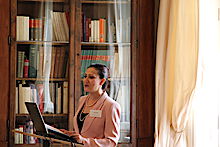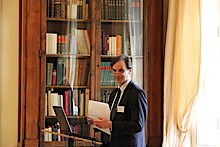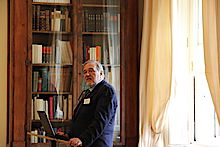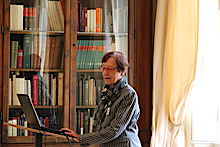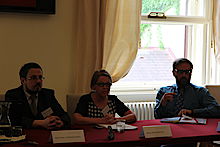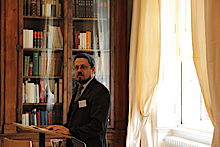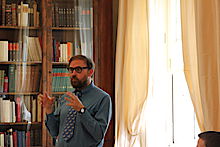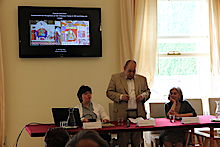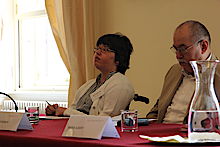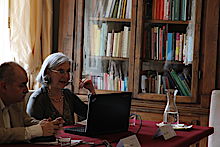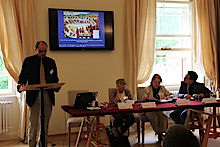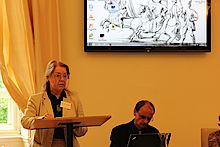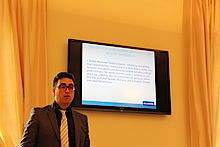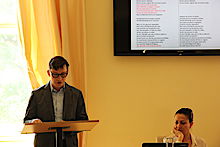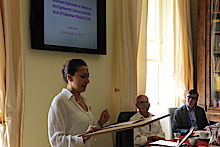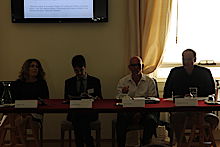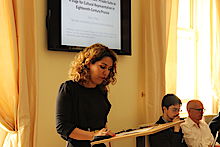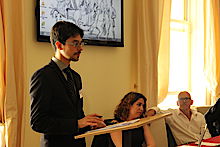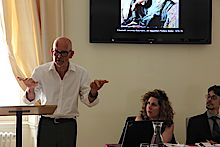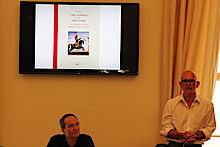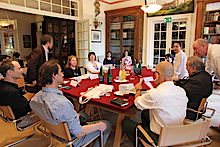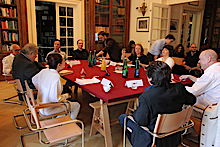Maria Alberti
PhD in History of Theatre at the University of Florence: Turkish Occurrences in Florentine Performances in Sixteenth and Seventeenth Centuries. Currently, she teaches at the Academy of Fine Arts in Venice, after having taught for many years at Siena University. Her field of research is focused on the links between politics and entertainment in Italian courts of Ancient Régime. She also worked at the reorganization and cataloguing of important theatrical institutions Archives.
Her most recent publications are: “The Discovery of Theatre in Arab World. Theatre festivals of the Medici described by a special spectator: the Druze Emir Fakhr ad-Din”, in The Medici and the Levant, proceedings ed. by M. Caroscio and M. Arfaioli, Roma, Viella, (in print); Fakhr ad-Din II al-Ma’n, Viaggio in Italia (1613–1618). La Toscana dei Medici e il Mezzogiorno spagnolo nella descrizione di un viaggiatore orientale, a cura di M. Alberti, Milano-Udine, Jouvence, 2013; Spettacoli acquatici a Firenze e a Mantova tra Cinque e Seicento, in Tra boschi e marine. Varietà della pastorale nel Rinascimento e nell’Età barocca, a cura di D. Perocco, Bologna, Archetipolibri, 2013; “Le parti scannate per Il Solimano di Prospero Bonarelli”, in Studi di Storia dello spettacolo. Omaggio a Siro Ferrone, a cura di S. Mazzoni, Firenze, Le Lettere, 2011.
Irena Fliter
Irena Fliter is a PhD candidate at the School of History at Tel Aviv University and a fellow at the Orient-Institut Istanbul. Her research interests are in the private lives of Ottoman diplomats and the practical organization of the diplomatic missions between the Ottoman Empire and Prussia in the 18th and the early 19th centuries. She is further interested in contrasting Ottoman and Prussian memories of the missions and understanding the experience of live abroad. Currently, she works on an article on the practical challenges of financing Ottoman diplomatic missions to Prussia in the eighteenth century.
Bent Holm
Bent Holm. Born 1946. MA, Phil.Doc. Doctoral dissertation 1991, Solkonge og Månekejser. Ikonografiske studier i Francois Fossards Cabinet (‘Sun King and Emperor of the Moon. Iconographic Studies in Francois Fossard’s Cabinet’), about La Comédie Italienne in an anthropological and iconographic perspective. Interdisciplinary studies on historical and dramaturgical issues published in Danish, English, Italian, French and Polish. Dramaturg; published Holberg på tværs. Fra forskning til forestilling (‘Provoking Holberg. From Study to Stage’) in 2013 about the interplay between scholarly research and artistic creativity. Translator of plays, among others by Dario Fo and Carlo Goldoni. Studies in the relations between the Ottoman Empire and the European countries, such as “The Turk Unbound. The aptivity/Release Motif in Danish Theatrical Turqueries”, in NorthWest Passage 8, Turin 2011, “The Staging of the Turk. The Turk in the Danish Theatre of the Eighteenth Century” in Ottoman Empire and European Theatre I, Vienna 2013, and The Taming of the Turk. Ottomans on the Danish Stage 1596–1896, Vienna 2014. Received the Holberg Medal 2000. Cavaliere della Stella della Solidarietà Italiana 2006.
Nedret Kuran Burçoğlu
Comparatist and Translation Scholar Nedret Kuran-Burçoğlu is Professor at Yeditepe University, in Istanbul. She studied English Language and Literature, Modern Turkish Literature, German Literature and Culture and Translation Studies. Her publications focus on Translation Studies and Comparative Cultural Studies, comprising Comparative Literature, Imagology and other transnational, intercultural themes. Until 2000 she was teaching in Boğaziçi University, Istanbul. During the 2000–2001 academic year she was a visiting scholar at the Center for Middle Eastern Studies of Harvard University, USA. Since 2001 she has been teaching in various programmes of the Faculty of Science and Arts of Yeditepe University. She has initiated the following research projects, in which experts from various disciplines have taken part: Multiculturalism: Identity and Otherness (1997), The Image of the Turk in Europe from the Declaration of the Republic in 1923 to 1990s (2000), Representations of the ‘Other/s’ in the Mediterranean World and Their Impact on the Region (2004), A New Mediterranean Policy in the Making: Towards a Multicultural Dialogue, Coherence and Accountability and Turks in Germany – Germans in Turkey in historical, literary and political context. The texts of the first three projects were published as anthologies. The projects were supported by The Council of Europe, European Cultural Foundation, UNESCO and the Press Council of the Prime Minister. Her PhD thesis the Reception of J.W. von Goethe in Turkey and an Analysis on Faust Translations (1984) and her Habilitation Translation as an Intercultural Communication Phenomenon on the Example of Turkish and English Translations of Ingeborg Bachmann’s The Thirtieth Year (1993) were published by Boğaziçi University Press. Her book the History of Printing in the Ottoman Empire that she translated from Franz Babinger (2004) was published by the Turkish History Foundation. Her book entitled Die Wandlungen des Türkenbildes in Europa (2005) was published by Spur Verlag, in Zürich. Kuran-Burçoğlu is the President of the Crossroads Interdisciplinary Research and Policy Platform that she founded together with thirteen other scholars of social sciences in Istanbul.
Martin Nedbal
Martin Nedbal is Assistant Professor of Musicology at the University of Arkansas. He received his Ph.D. from the Eastman School of Music in 2009. His research focuses on German opera in Vienna in the late eighteenth century and on late-nineteenth century Czech opera. His articles on the operas of Mozart, Beethoven, and Dvořák appeared in Acta Musicologica, The Musical Quarterly, and Opera Quarterly. His research trips to Viennese archives have been supported by an Austrian Scholarship Foundation Fellowship in 2011 and most recently also by the Holmes/D’Accone Award from the American Musicological Society. He is currently working on a monograph on didacticism and morality in Viennese singspiel in the late eighteenth century.
Matthias J. Pernerstorfer
Born in 1976, Eggenburg, Lower Austria. He studied theatre, film and media in Vienna and Munich, having completed a dissertation on the character of the parasite in Ancient Greek Comedy (2001). He received a fellowship (DOC) from the Austrian Academy of Sciences for a thesis on the “Colax” of Menander from 2003 to 2005. Afterwards he worked for the Viennese Da Ponte Institute for Libretto Studies, Don Juan Research und History of Collecting from 2005 to 2006. Since 2007 he is member of the Don Juan Archiv Wien, working on different projects on the popular theatre in Vienna in the 18th and 19th centuries. Since 2012 he is director of the Don Juan Archiv Wien.
Publications on Ancient Greek Comedy and Viennese Theatre, including “Karl von Marinellis Spaziergang in den Prater”, Nestroyana 2009, Heft 1–2 (2009), pp. 23–32; “Editions and Cultural Translations. Der 30-jährige ABC-Schütz in German Speaking Lands”, in: Federico Italiano and Michael Rössner (eds.), Translation. Narration, Media and the Staging of Differences, Bielefeld: Transcript 2012, pp. 121–142; “Ferdinand Raimund in Telč. Zu Schlosstheater und Theaterbibliothek der Grafen Podstatzky-Lichtenstein”, Nestroyana 32, Heft 1–2 (2012), pp. 33–46.
Menanders Kolax. Ein Beitrag zu Rekonstruktion und Interpretation der Komödie. Mit Edition und Übersetzung der Fragmente und Testimonien sowie einem dramaturgischen Kommentar, Berlin – New York: De Gruyter 2009 (Untersuchungen zur antiken Literatur und Geschichte 99); Matthias J. Pernerstorfer (ed.), Theater – Zettel – Sammlungen. Erschließung, Digitalisierung, Forschung, Wien: Hollitzer Wissenschaftsverlag, 2012 (Bibliographica 1); Alena Jakubcová and Matthias J. Pernerstorfer (eds.), Theater in Böhmen, Mähren und Schlesien. Von den Anfängen bis zum Ausgang des 18. Jahrhunderts. Ein Lexikon. Neu bearbeitete, deutschsprachige Ausgabe. Wien: Verlag der Österreichischen Akademie der Wissenschaften 2013 (Theatergeschichte Österreichs X: Donaumonarchie/Heft 6).
John Plemmenos
Dr. John Plemmenos has studied Law in the University of Athens, and holds an MPhil and PhD in Ethnomusicology from the University of Cambridge, with a Scholarship from the British Academy. He has taught as lecturer in various Greek universities and in 2008 he was elected Research Fellow at the Hellenic Folklore Research Centre, Academy of Athens. He has published extensively, including a concise version of his thesis (2010), and has edited two volumes in the Academy of Athens (2010, 2011). He is a member of the Greek Folklore Society and the Advisory Board of the Journal of Interdisciplinary Music Studies, and has contributed to Grove Music Online.
Luca Scarlini
Luca Scarlini (Florence, 1966) is a playwright, essayist, translator, arts administrator and editorial consultant and teacher about relationships bertween literature and music, writing regularly for opera houses and concert hall in Italy and Belgium. He works since a long time in music iconography; has curated the exhibition Sylvano Bussotti Corpi da musica, Florence, Museo Marino Marini, 2010. He had worked extensively, about the relationship between eastern and western imagery in music, working about Turqueries by Karl Henrici (Bozen, 2006) and writing the book La paura preferita (2004), devoted to the presence of Muslim Imagery in Italy, studying the story of Belly Dance and the relationships between popular music and eastern influences.
Arno Strohmeyer
Arno Strohmeyer (Ph.D., University of Salzburg, Professor) studied history and cultural anthropology at the University of Vienna (1982–1991). His Ph.D. thesis “Theory of Interaction: The Balance of European power in Early Modern Time” was published in 1994. From 1992 to 1994 he was scientific assistant for exhibitions at the cultural department of the Lower Austrian state Government. From 1994 to 1996 he was research assistant at the Department of History at the University of Vienna. In 1996 he started as a research associate at the “Geisteswissenschaftliches Zentrum für Geschichte und Kultur Ostmitteleuropas” in Leipzig, Germany. From 2001 to 2004 he was assistant lecturer at the Department of History at the University of Bonn, Germany. He received postdoctoral lecture qualification in 2003. His professorial dissertation “Confessional conflict and system of rule. The right to resist for Austrian estates (1550–1650)” was published in 2006. From 2004 to 2007 he was associate professor at the University of Bonn. In 2006 he was guest lecturer at the History Department at the University of Vienna and in 2007 at the University of Salzburg. 2007 he became professor for Modern History at the University of Salzburg. Since 2013 he is corresponding member of the Austrian Academy of Sciences.
Suna Suner
Suna Suner (Dr. phil., M.A.) is a theatre scholar and a stage performer. Born in Ankara, Suner received her B.A. degree in Conference Translation & Interpretation (Turkish & English) from Hacettepe University. She taught at Istanbul Bilgi University (1996–2002), and received in 2004 her M.A. degree in Performing Arts from the Middlesex University in London. She worked as stage performer (1997–2003) at the Istanbul-based Kumpanya Theatre; and sang in numerous Turkish festivals and venues. Stage projects include: Farewell Blues (Istanbul, 1997/2001), The Trouble of Margaret Walker (Istanbul, 1999/2001), In the Heat of Our Own Pictures (Vienna, 2005), Poem for Family/De Rien (1st International Sinop Biennial Sinopale, 2006). Latest performance work in the performance-action Österreicher Integriert Euch!, a production within Wiener Festwochen (2012). Since 2007 she is a member of Don Juan Archiv Wien’s team and has been conducting research in theatre and diplomatic history in Ottoman-European context. Since 2008 she has co-directed and organized Don Juan Archiv Wien’s international symposia series “Ottoman Empire & European Theatre”. She received in 2013 her doctoral degree from the Institute of Theatre, Film & Media Studies at the University of Vienna. Other projects conducted at Don Juan Archiv Wien include Theatre and Diplomacy, Ottoman Empire & European Theatre, Sefâretnâmes – Ottoman Embassy Reports Edition.
Nevin Zeynep Yelçe
Nevin Zeynep Yelçe is a post-doctoral fellow at Sabancı University. Her MA thesis has been published with the title Ideal kingship in the late medieval world: The Ottoman case (Saarbrücken/ Germany: LAP Lambert Academic Publishing, 2010). In 2009 she has defended her dissertation “The Making of Sultan Süleyman: A Study of Processes of Image-Making and Reputation Management” at Sabancı University. Her project as a TCF Turkish Cultural Foundation Post-Doctoral Fellow in 2012 was titled “A Glance at the Ottoman Envoys in Venice in the Diarii of Marino Sanuto”. The results of the project were shared partially in two conferences: “Persons Worthy of Trust: Venetian Informants at the End of the Fifteenth Century”, Third Biennial Conference of the Society for the Medieval Mediterranean: Trade, Travel and Transmission in the Medieval Mediterranean, Churchill College, University of Cambridge, 8–10 July 2013, Cambridge, UK; and “A Glance at the Ottoman Envoys in Venice in the Diarii of Marino Sanuto”, 14th Mediterranean Research Meeting, Mediterranean Programme, European University Institute, March 20–23, Mersin.
Dirk Van Waelderen
Dirk Van Waelderen is employed at the Katholieke Universiteit Leuven (KU Leuven) as coordinator for the exchange programmes of the integrated faculties (Arts, Law, Economics and Business) at campus Brussels. At the KU Leuven (campus Leuven) he’s working on his Phd Research in Early Modern History on the portrayal of the Ottomans in the Spanish and Austrian Netherlands. He previously studied at the Katholieke Hogeschool Brussel and KU Leuven. He graduated in Leuven on the topic of the Ottomans and the siege of Vienna. During his studies at the latter university he also participated in an exchange at the “Institut Orientalistique” de l’Université Catholique de Louvain.
Luca Zuccolo
Dr. Luca Zuccolo an Italian researcher. In 2008 he achieved his master’s degree in Contemporary History at Bologna University, in 2012 he completed his PhD studies in Contemporary History at the Italian Institute of Human Sciences (SUM) in Naples with a dissertation on the formation of a patriotic speech in the late Ottoman Empire analyzing several francophone newspapers edited in Istanbul. During the last four years he has worked as co-editor in Diacronie, an on-line review (www.diacronie.it), and in March 2014 he finished his second degree in Oriental Languages at Ca’ Foscari University in Venice. Recently he has published in Diacronie a monograph and an article on the role of monarchy during the national period, and works on a project about the political exile and innovation with the Université de Paris Est-Creteil (UPEC), directed by Catherine Brice.
